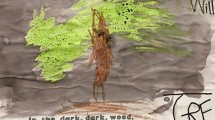Abstract
Dr. Maria Montessori was a perceptive observer of the learning processes of children, and nowhere is this revealed more clearly than in her approach to language. She viewed reading as the ultimate abstraction of language rather than a specific skill to be taught. Decoding is the skill to be taught. The concept of indirect and direct preparation for learning is of major importance in the rich heritage she gave us. She saw the existence of an epigenesis of intellectual functioning, which implies that the experiential roots of a given schema, or learned behavior, will lie in antecedent activities that may be quite different in structure from the schema to be learned. She used this principle effectively. This article discusses how Montessori’s method and materials address the indirect and direct preparation for learning written language.
Similar content being viewed by others
References
Berlyne, D. E. 1963. Soviet research on intellectual processes in children. Monograph of Social Research in Child Development 28:165–83.
Bradley, L., and Bryant, P. E. 1983. Categorizing sounds and learning to read—A causal connection. Nature 30:219–41.
Itard, J-M-G. 1962. The Wild Boy of Aveyron. (George and Muriel Humphrey, tr.) New York: Appleton-Century-Croft. Originally published in 1884.
Liberman, I. Y. 1989. Phonology and beginning reading revisited. In Wenner-Gren International Symposium Series: Brain and Reading, ed. C. VonEuler. Hampshire, England: Macmillan.
Lyon, G. R. 1995. Research Initiatives in learning disabilities: Contributions from scientists supported by the National Institute of Child Health and Human Development. Journal of Child Neurology 10: Supplement No. 1, S120-S126.
Montessori, M. 1912. The Montessori Method. New York: F. A. Stokes.
Montessori, M. 1965. Dr. Montessori’s Own Handbook. New York: Schocken Books.
Orton, J. L. 1957. The Orton story. Bulletin of The Orton Society, 7:5–8.
Piaget, J. 1952. The Origins of Intelligence in Children. (Margaret Cook, tr.). New York: International Universities Press. Originally published in 1936.
Richardson, S. O. 1969. Curricular considerations in programs for the retarded: Application of the Montessori model. In Montessori and the Special Child, ed. R. C. Orem. New York: Capricorn Books.
Richardson, S. O. 1991. Evolution of approaches to beginning reading and the need for diversity in education. In All Language and the Creation of Literacy, ed. W. Ellis. Baltimore: The Orton Dyslexia Society.
Seguin, E. 1907. Idiocy and Its Treatment by the Physiological Method. New York: Columbia University Press.
Zaporozhets, A., and Elkonin, D. 1971. The Psychology of Preschool Children. Cambridge, MA: MIT Press.
Author information
Authors and Affiliations
Rights and permissions
About this article
Cite this article
Richardson, S.O. The montessori preschool: Preparation for writing and reading. Ann. of Dyslexia 47, 239–256 (1997). https://doi.org/10.1007/s11881-997-0028-4
Issue Date:
DOI: https://doi.org/10.1007/s11881-997-0028-4




